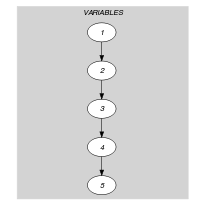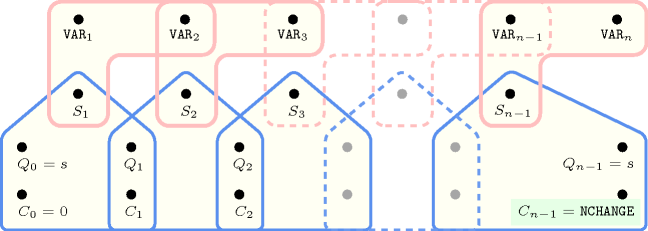5.107. cyclic_change
| DESCRIPTION | LINKS | GRAPH | AUTOMATON |
- Origin
- Constraint
- Arguments
- Restrictions
- Purpose
is the number of times that constraint holds; and correspond to consecutive variables of the collection .
- Example
-
Since is set to and since is set to 4, a change between two consecutive items and of the collection corresponds to the fact that the condition holds. Consequently, the constraint holds since we have the two following changes (i.e., ) within :
A first change between the consecutive values 0 and 2,
A second change between the consecutive values 3 and 1.
However, the sequence does not correspond to a change since is equal to 0.
- Typical
- Symmetry
Items of can be shifted.
- Arg. properties
Functional dependency: determined by , and .
- Usage
This constraint may be used for personnel cyclic timetabling problems where each person has to work according to cycles. In this context each variable of the collection corresponds to the type of work a person performs on a specific day. Because of some perturbation (e.g., illness, unavailability, variation of the workload) it is in practice not reasonable to ask for perfect cyclic solutions. One alternative is to use the constraint and to ask for solutions where one tries to minimise the number of cycle breaks (i.e., the variable ).
- See also
common keyword: , (number of changes).
implies: .
- Keywords
characteristic of a constraint: cyclic, automaton, automaton with counters.
constraint arguments: pure functional dependency.
constraint network structure: sliding cyclic(1) constraint network(2).
constraint type: timetabling constraint.
- Arc input(s)
- Arc generator
-
- Arc arity
- Arc constraint(s)
- Graph property(ies)
-
- Graph class
-
- Graph model
Parts (A) and (B) of Figure 5.107.1 respectively show the initial and final graph associated with the Example slot. Since we use the graph property, the arcs of the final graph are stressed in bold.
Figure 5.107.1. Initial and final graph of the constraint


(a) (b)
- Automaton
Figure 5.107.2 depicts the automaton associated with the constraint. To each pair of consecutive variables of the collection corresponds a 0-1 signature variable . The following signature constraint links , and : .
Figure 5.107.2. Automaton of the constraint

Figure 5.107.3. Hypergraph of the reformulation corresponding to the automaton of the constraint
